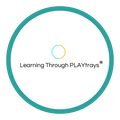How to Use Core Communication Boards in Sensory Play

Table of contents
At Learning Through PLAYtrays®, we believe that play is for everyone — and that includes communication. Whether a child is verbal, nonverbal, or developing early language skills, communication happens in many ways — through gestures, expressions, movement, and play. That’s where Core Communication Boards come in.
What Is a Core Board?

A core communication board is a visual tool that displays symbols or words representing essential vocabulary — the “core words” we use most often in daily communication. These are the building blocks of language: words like go, want, help, stop, look, and more.
Core words make up around 80% of what we say every day, regardless of age or ability. Because these words are so universal and flexible, they can be used across any setting — whether you’re playing with sand, painting, cooking, or reading.
A core board provides consistent access to those words in one easy-to-see place. For children who use AAC (Augmentative and Alternative Communication), a board can be a bridge between thoughts and expression. For verbal children, it reinforces literacy and builds word awareness.
Why Use a Core Board?
A core communication board gives a child a voice — it provides consistent access to essential words that make up most of our daily communication. For children who are developing language skills, experiencing speech delays, or are nonverbal, a core board creates an opportunity to communicate wants, needs, ideas, and feelings.
When paired with sensory play, core boards turn everyday exploration into powerful communication moments — encouraging children to say, show, or point to what they are doing, seeing, and feeling.

What’s the Difference Between Core and Fringe Words?
Core words are high-frequency, general words that can be used in any situation (like want, go, more, stop, help).
Fringe words are specific to a topic or theme (like sand, pumpkin, mix, paint, flower).
When used together, they give children both versatile communication power and context-specific vocabulary. For example, during sensory play a child might use more (core) and sand (fringe) together to say “more sand.”
Using a Core Board During Sand Play
Sand play is one of the most powerful sensory experiences for early learners — it’s open-ended, calming, and full of natural opportunities for communication. When paired with a core communication board, it becomes more than just play — it becomes an opportunity to give every child a voice.
As children scoop, pour, dig, and build, you can model simple core words that match their actions:
Go – when the sand flows down a funnel.
More – when they ask to refill a bucket.
Help – when a tower falls down.
In / Out – when burying and uncovering toys.
Look – when exploring textures or shapes.
Our Sand Play Core Bundle includes 10 easy, low-prep activities designed to build communication through play. No extra toys needed — just add sand and start exploring.

You can explore our full Core Communication Board Collection on Teachers Pay Teachers (TPT).
Teachers Pay Teachers (TPT) is a trusted online marketplace where educators share classroom-tested resources. We chose to offer our digital communication boards there because it allows teachers, parents, and therapists to instantly download, print, and start using our boards in their own classrooms or therapy sessions.








